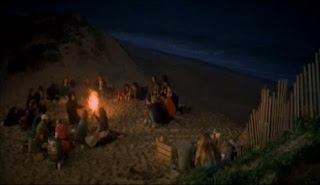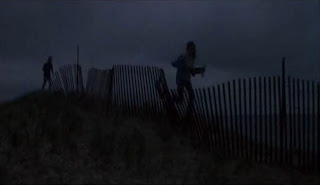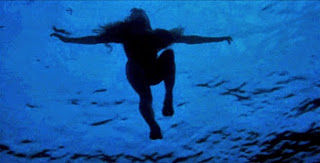Louise De Cristofaro Media Studies!
Thursday, 25 February 2016
Wednesday, 9 December 2015
How does CSI: One Hit Wonder grab the attention of the audience?
In the first few minutes of the episode, an enigma code is
set up to set the scene of the entire episode, without revealing too much of
the attacker. This creates suspense because it tells you what has happened
without revealing too much which means the audience have to watch the full
episode to find out. These enigma codes have became a convention for all the
CSI series as something similar happens in every episode and a frequent viewer
will know it will happen and will be trying to predict how the scene plays out.
In the opening shot, the camera is at a high angle showing a
high shot looking down on the city. This makes it look like anyone in the city
is a target. Police sirens can be heard in the background implying something
bad has or will happen.
There is a jump cut using a quick fade to white and fade up
between shot 1 and 2. This unnerves the audience, adding more suspense to the
scene. A second quick fade to white and fade up using graphic match causes the
city to be reflected in the glasses and bottle on the table. There is a fade to
black and fade up which shows a red towel in the darkness. The red symbolises
blood and death and the darkness implies the threat of danger.
In the next shot, the camera pans around implying someone is
walking around the room. This grabs the audience’s attention by given them the
point of view of the ‘intruder’. A series of non-diegetic atonal crescendos create
an atmosphere of fear.
The camera panning around the room allows the audience to read
into the mise-en-scene. The woman’s trainers on the floor show that the victim
is most likely to be a young vulnerable woman. The treadmill blocking the door suggests
that it is there to protect the girl which also links back to something bad
happening. The room being in darkness implies the threat of danger. The only light
in the room is on the red towel which has connotations of blood and violence.
The shot dissolves and the camera tracks towards the bed. The
mise-en-scene is dark linking back to danger. The camera makes it look like she
is being looked over and is vulnerable. The shot then fades into blackness
implies that time is passing.
The next shot fades up on a close-up of a young female’s head
on a pillow. The camera does not show the audience more of the scene to keep
the suspense. There is a crescendo of music up to when she hears a noise and
she turns, implying someone is there.
She wakes and turns and there is another dissolve. The camera
angle is high showing she is the victim. The mise-en-scene is dark and the
shadows of blinds make it look like she is trapped. When she turns the light
on, it shows that the room is empty; however, the low music makes it feel like
some was there.
The girl is wearing tight, short skimpy night clothes. This
makes her vulnerable and an easy target by making her like a stereotypical,
young attractive female victim.
The draught that turns over the pages of the magazine
unsettles the audience by making it looking like someone was there. The camera
then tracks out and she looks up to the fan which caused the pages to turn. The
camera is looking down on her in close up as if she is being singled out as the
victim.
As the fan turns, she turns and the camera closes in on the
fan switch which has marks showing that someone has been in her house whilst she
was asleep. The cut back to the woman in medium shot in the middle of the frame
shows she is isolated. As the camera zooms into her face, she looks down. It
then cuts to the camera looking up at her from under the glass table. The
camera focuses on her then focuses on the table, showing the audience that she
is looking at spilt water on the table. There is a crescendo of music as she
turns, making it obvious that she knows someone was there and the audience
realise this too. There is another cut to show her reaction. She panics and is
framed with the door to her left as if someone has come through it or will come
through it.
The camera then zooms in on the door handle and continues
going through the keyhole into the lock of the woman’s house next door. We then
hear women’s screams from next door, telling the audience that something has
happened when the audience weren’t being shown.
There is another jump cut and sfx shot to zoom through the
lock in the door. We then see the camera tracking through the victim’s house.
The camera leads us to her bedroom to where she is being attacked. In the final
scene, the woman is being held down on her bed by an intruder in an unreal blue
light, this creates and eerie atmosphere.
The camera cuts to the intruder’s sole of his shoe in a close
up shot as he leaps off the bed in slow motion. The audience are shown the shoe
because it is used later on in the show as evidence. In this shot, there is a
crescendo to emphasise her screams and a drum beat gets faster as he’s getting
off the bed. Because it is shown in slow motion, it implies she was in pain for
a long time.
In conclusion, the director uses many techniques to grab the audience’s
attention. These are things such as using classic horror movie conventions like
a dark mise-en-scene and the iconic use of the colour red. Another thing is the
use of sound, for example crescendos to build tension. What also helps to grab
the audience’s attention is the setting up of an enigma code at the start of
the episode, this is because a regular viewer would be expecting and would know
this was going to happen. This would mean that they would want to solve the
crime scene along with the detectives.
Friday, 16 October 2015
Sound
Diegetic - Within the scene
Non diegetic - Added afterwards in post production
Crescendo - Build up of sound/music
Diminuendo - Gradual 'die away' of music
Sforzando - Sudden sharp sound
Jaws
In the first scene of Jaws, the music starts diegetic, then when the boy and girl leave the group the music is diminuendo because they are getting further away from the fire. When the scene was in the sharks point of view, the music started playing a crescendo when it was approaching the girl in the water. When the girl was being dragged around, the music speeds up and so does the speed of her being pulled around the water.
The Godfather
In The Godfather scene, it is diegetic until Michael leave the toilet cubical with the gun. At this point, you can hear the noise of a train as a crescendo. Michael then leaves the room and goes back to the table, it stays non diegetic.
Non diegetic - Added afterwards in post production
Crescendo - Build up of sound/music
Diminuendo - Gradual 'die away' of music
Sforzando - Sudden sharp sound
Jaws
In the first scene of Jaws, the music starts diegetic, then when the boy and girl leave the group the music is diminuendo because they are getting further away from the fire. When the scene was in the sharks point of view, the music started playing a crescendo when it was approaching the girl in the water. When the girl was being dragged around, the music speeds up and so does the speed of her being pulled around the water.
The Godfather
In The Godfather scene, it is diegetic until Michael leave the toilet cubical with the gun. At this point, you can hear the noise of a train as a crescendo. Michael then leaves the room and goes back to the table, it stays non diegetic.
Thursday, 8 October 2015
Main Edits
- Cut
- Dissolve
- Fade into black/white and fade up - pace can be changed on this one (often time passing)
- Just cut - object in some position but a closer shot
- Graphic match - the image of one object fades/dissolves/cuts into another similar
Alfred Hitchcock's - Psycho
In the film, when the girl is getting murdered, the shots cut quickly. The pace of the cutting creates excitement and tension. It also helps to not show the viewers that the knife isn't actually stabbing into her.
Graphic match - The camera focus' on the plughole and then fades into her eyeball.
The camera then turns and focus' on the money she stole.
Wednesday, 7 October 2015
Basic Camera Shots
Extreme close-up (ECU)

A very close shot that emphasises a reaction.
Close Up (CU)

Face and head; shows details of character.
Medium close-up (MCU)

Head and shoulders.
Medium shot (MS)

Just above or below the waistline.
Medium-long shot (MLS)

Usually just above the knees.
Long shot (LS)

Full length of figure - head to toe
Extreme long shot (ELS) of wide shot (WS)

A scenic shop that shows location, setting ect.
Over the shoulder (OTS)

Shows character over another character's shoulder.

A very close shot that emphasises a reaction.
Close Up (CU)
Face and head; shows details of character.
Medium close-up (MCU)
Head and shoulders.
Medium shot (MS)

Just above or below the waistline.
Medium-long shot (MLS)

Usually just above the knees.
Long shot (LS)
Full length of figure - head to toe
Extreme long shot (ELS) of wide shot (WS)
A scenic shop that shows location, setting ect.
Over the shoulder (OTS)

Shows character over another character's shoulder.
Friday, 2 October 2015
Mise-en-scene - Opening scene of Jaws
- Opening scene starts with the sharks p.o.v as it swims
- We hear non-diegetic low, stringed music - associated with the shark
- Camera tracks past kids around camp fire
- Fire is source of light
- Girl and boy on edge of group - outsiders
- Medium close up of the girl - bars of fence behind her - suggests she is trapped
- High angled shot makes them look vulnerable

- Boy and girl run off from the light of the fire into the darkness
- Bars all around them - suggesting they're both trapped

- Music gets quieter showing that they are getting further and further away and gets replaced with the sound of the sea - leaving other people - putting themselves in danger
- Long shot - calm - in the moonlight - peaceful
- Only sound you can hear is the buoy
- Sunset - Symbolises the girl's life ending
- Jumps from longshot to close shot - brings audience closer to the action
- Music comes back of during the sharks p.o.v under the water

- Cuts away from the action - doesn't give anything away
- Noise from the water crashing is loud to show chaos and mayhem
- Music suddenly stops when girl goes underwater - symbolises she is dead
- Cuts back to the boy to show he wasn't aware of anything

Thursday, 24 September 2015
The Woman in Black - Mise-en-scène
-
What is Mise-en-scene?
- Mise-en-scene is everything within the frame - setting, lighting, costume, framing and composition, colours, expression, make up.
Creation of the mise-en-scene can influence the way the audience reads the scene/its interpretation of characters or situation.
Semiology - The study of signs/symbols - helps create depth to the scene.
- Limited colour - mostly greys - reflects the sadness in the film
- Isolating themselves
- Passes grave marker - dramatic irony
- Kipps hasn't shaved - shows he isn't looking after himself
- Gravestones connotations of death
- Overgrown trees - no one else around
- Dressed in black
- Camera looking up at the house to make it look bigger and more threatening
- Camera pointing down on him through window - suggesting someone is watching him
- Dusty rooms - dead animals hanging up
- He's framed in a doorway and behind that you can see the woman in the back
Subscribe to:
Comments (Atom)





